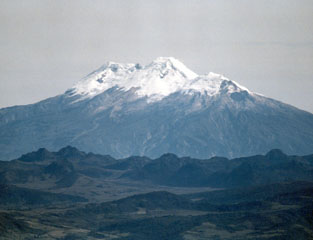Report on Nevado del Huila (Colombia) — November 1994
Bulletin of the Global Volcanism Network, vol. 19, no. 11 (November 1994)
Managing Editor: Richard Wunderman.
Nevado del Huila (Colombia) Tremor pulses follow the 6 June earthquake
Please cite this report as:
Global Volcanism Program, 1994. Report on Nevado del Huila (Colombia) (Wunderman, R., ed.). Bulletin of the Global Volcanism Network, 19:11. Smithsonian Institution. https://doi.org/10.5479/si.GVP.BGVN199411-351050
Nevado del Huila
Colombia
2.93°N, 76.03°W; summit elev. 5364 m
All times are local (unless otherwise noted)
After the Paez earthquake (6 June 1994) tremor pulses began appearing on local seismic records. Such pulses were previously unseen since seismic monitoring began in 1986. On 7 August, a 75-minute interval of banded tremor took place over a 4-hour time span. On 27 September continuous tremor prevailed for up to 9.5 hours; the dominant frequency was in the 1-2 Hz range.
Geological Summary. Nevado del Huila, the highest peak in the Colombian Andes, is an elongated N-S-trending volcanic chain mantled by a glacier icecap. The andesitic-dacitic volcano was constructed within a 10-km-wide caldera. Volcanism at Nevado del Huila has produced six volcanic cones whose ages in general migrated from south to north. The high point of the complex is Pico Central. Two glacier-free lava domes lie at the southern end of the volcanic complex. The first historical activity was an explosive eruption in the mid-16th century. Long-term, persistent steam columns had risen from Pico Central prior to the next eruption in 2007, when explosive activity was accompanied by damaging mudflows.
Information Contacts: H. Cepeda, INGOMINAS, Popayan.

